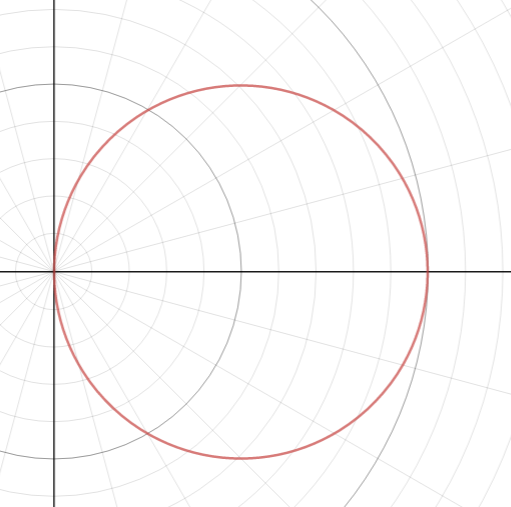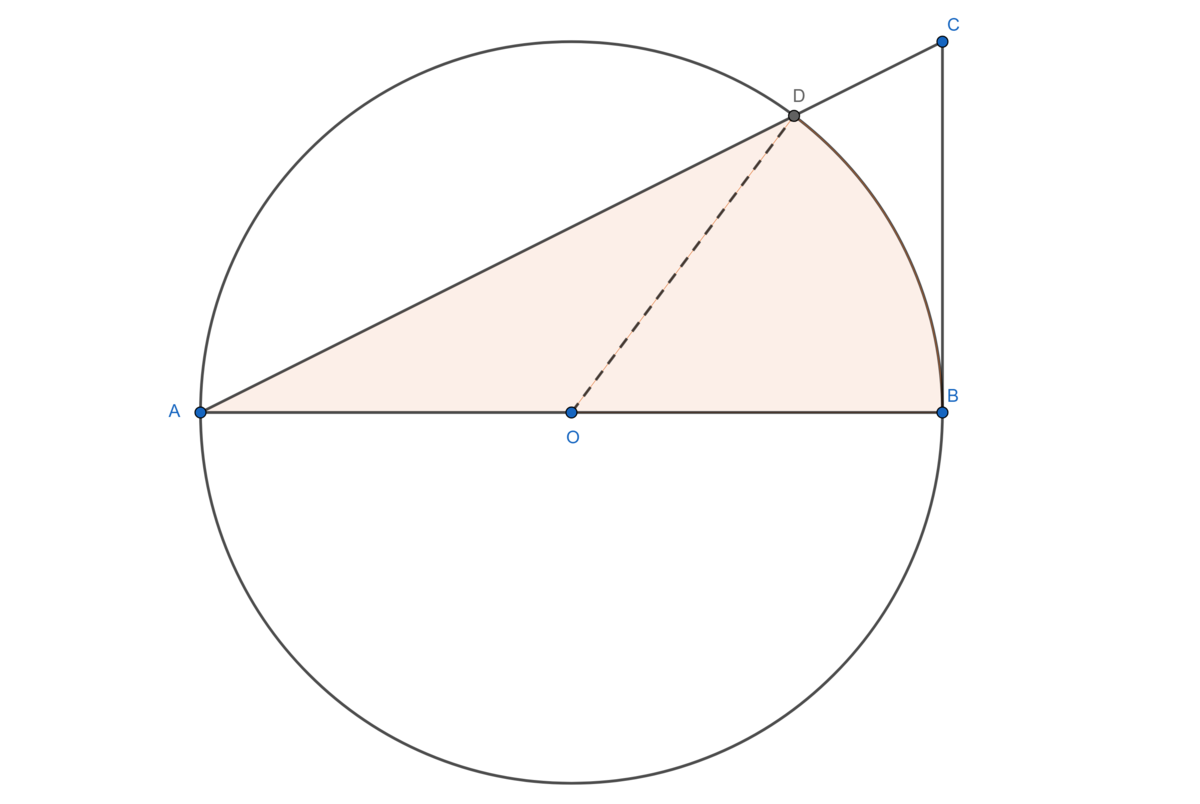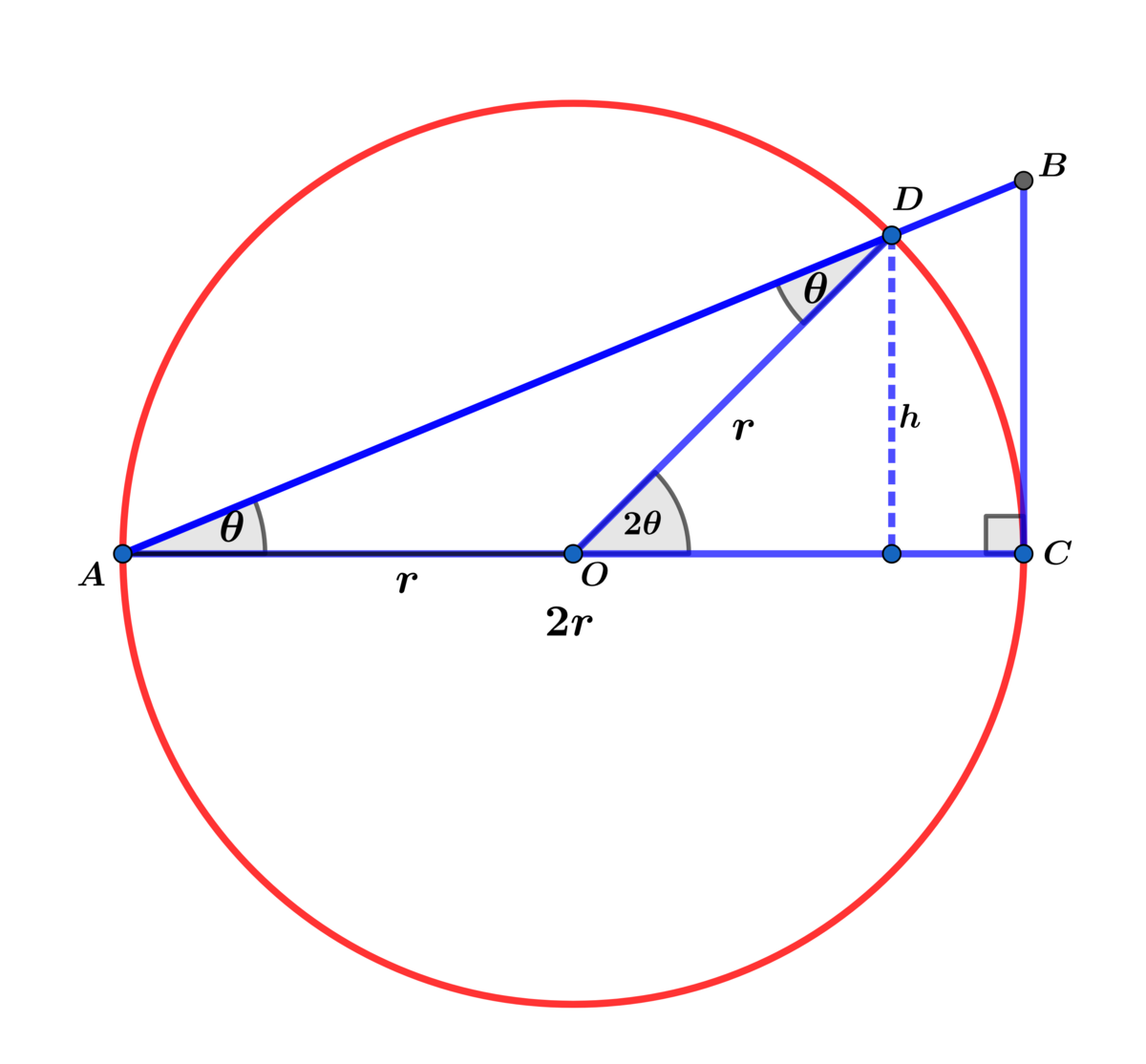Orange Shaded Area
A B is the diameter of the circle.
What is the orange area in terms of r and θ ?
This section requires Javascript.
You are seeing this because something didn't load right. We suggest you, (a) try
refreshing the page, (b) enabling javascript if it is disabled on your browser and,
finally, (c)
loading the
non-javascript version of this page
. We're sorry about the hassle.
8 solutions
Why is CB=r?
Log in to reply
Sorry, wrongly labelled.
Log in to reply
Thanks, I like this solution much better :)
you want to hear some thing funny i am only 11 and i got this question right.
Log in to reply
Congratulations!
Log in to reply
@Chew-Seong Cheong – thanks Chew-Seong Cheong. by the way how did you come up with that name?
CB is not necessarily equal to r, but OB is always equal to r.
Isn’t theta should be the angle of A? Why do you divide it by 2?
Log in to reply
The original problem has the central angle as θ . The problem has changed when put into this weekly problem. I will change the solution later.
Is there any use of radian in the solution?
Log in to reply
Yes, the formula for area of sector D O B has to be in radian. I have changed the 1 8 0 ∘ to π .
Without radian you cannot define s=r×theta
I get that area of triangle DOB is theta X r^2. But the area of triangle ADO is half times base times height. Base is 2r and height is r times sin(theta) [cut triangle in half so hypotenuse is r and h is perpendicular bisector of ADO]. So area of ADO is r squared times sin(theta). Total area is thus (theta + sin(theta)) r squared. No? What am I doing wrong???
Log in to reply
The base of △ A D O is A O = r and not 2 r . The height is r sin ( 2 θ ) . Therefore the area A △ A D O = 2 1 r 2 sin ( 2 θ ) .
How would a noob know area of that sector is theta×r^2
Log in to reply
Area of a circle is π r 2 . Area of a sector of ϕ radian is therefore 2 π ϕ × π r 2 = 2 ϕ r 2 , If ϕ = 2 θ then the area is θ r 2 .
How is pi - 2 theta = 2 theta?
Log in to reply
@Sam Oli It's sin(π-2θ)=sin(2θ). I hope you were asking about the same. Hints: Unit circle(or any circle centered at origin) is symmetric to origin (X and Y-axis). sine function gives y-coordinate as result to given value of angle. Because of circle is symmetric to Y-axis, sin(π-θ)=sin(θ)
Consider sin ( π − x ) = sin π cos x − cos π sin x = sin x .
Log in to reply
I had the same question and I know they are equal now, I understood why sinπcosx−cosπsinx=sinx, but could you please explain to me why or you can change sin(π - x) = sinπcosx - cosπsinx?
Mhm, I don't get it. Let's test it out. Put an actual value instead of theta. 90 and 180 degrees or pi/2 and pi, not sure how you write it down in Murica.
As we see on the graphic, the result should be the same, since for both 90 and 180 degrees the orange area will be the same (top half of the circle). Or in other words it should be (pi*r^2) / 2.
But, your equation gives us: 1/2 * (180 + 0) * r^2 = (pi r^2)/2 for 90 degrees, which is right, and 1/2 * (360 + 0) * r^2 = pi r^2
Oh sh1t, nvm, I am dumb. We are talking about triangle, not just some random ass sector.
Log in to reply
In this case θ should be less than 9 0 ∘ . When θ = 9 0 ∘ , we cannot have a triangle.
Mathematical😎😎
Area of a triangle is 1/2×base×height Tan theta is height/base. But base is 2r. Thus height is tan theta×2r. Put this in above formula we get: 1/2(2r×tan theta)×2r Thus area is 2r^2tan theta.
Log in to reply
The base of △ A D O is r . I was using the formula A △ = 2 1 a b sin ϕ , where a = b = r and ϕ = π − 2 θ .
How are you able to use the sine function for angle AOD? Triangle ADO isn't a right triangle.
Log in to reply
For any triangle A B C , the area of the triangle is A △ = 2 1 a b sin C . Note that ∠ C is between sides a and b . Let b be the base then the height h = a sin C . Therefore A △ = 2 1 b h = 2 1 a b sin C .
Is theta rad or deg
Really nice. Thank you OP, for the post and responses to comments.
did you say pi-2theta=2theta
A "Beating the Test" solution:
For
θ
→
2
π
, half of the circle will be filled and
A
→
2
π
r
2
.
Plug
θ
=
2
π
for each of the choices:
2 π r 2
( 2 π + 1 ) r 2
2 ( 2 π + 1 ) r 2
8 π r 2
So the first choice must be correct.
That's exactly how you solve JEE questions!
This is how I did it as well!
That way, you are depriving yourself of a good opportunity to develop your problem solving skills. Brilliant offers these problems as multiple choice questions, because it needs a simple user interface. In most cases, I would recommend not looking at the answer options when attempting to solve a problem.
You cannot have theta=π/2. That's an impossible triangle.
Log in to reply
Yep. But allowing theta to approach π/2 gives us an easy way to determine which of the equations yields a correct answer in the max limit.
That's how I did it. But I have a question what if any other option might have same value for pie/2. It was lucky for us that no other option comes out with same value. I want to know what would had you done in this scenario.
The question is the same as asking, "What is the area delimited by the polar curve r = 2 a c o s θ , the half line θ = t and the pole?"
To prevent confusion, I replaced r in the diagram with a , and θ in the diagram with t , so that I can use the r and θ as variables in the conventional polar way.
r
=
2
a
c
o
s
θ
, by the way, will appear like this on a polar graph:

To calculate the area, I will use the formula: A r e a = ∫ a b 2 1 r 2 d θ ,
And 2 1 r 2 = ( 2 a c o s θ ) 2 = 2 1 4 a 2 c o s 2 θ = 2 a 2 ( 2 1 + c o s ( 2 θ ) ) = a 2 ( 1 + c o s ( 2 θ ) )
Therefore the area is: A r e a = a 2 ∫ 0 t 1 + c o s ( 2 θ ) d θ = a 2 [ θ + 2 s i n ( 2 θ ) ] 0 t = 2 1 ( a 2 ) ( 2 t + s i n ( 2 t ) ) ,
Since t and a are just dummy variables, using the given variables in the problem: 2 1 ( 2 θ + s i n ( 2 θ ) ) r 2
That's a bull's-eye
I like this approach. Same one that I used.
who can help me deal with sector area’s function?
I will use the following diagram:
 Let
O
be the center of the circle and let
D
be the intersection of the circle and
A
C
. Construct radius
O
D
. The area of the shaded region is thus
A
r
e
a
(
△
A
O
D
)
+
A
r
e
a
(
B
O
D
)
where
B
O
D
represents the circular sector bounded by
O
B
and
O
D
.
Let
O
be the center of the circle and let
D
be the intersection of the circle and
A
C
. Construct radius
O
D
. The area of the shaded region is thus
A
r
e
a
(
△
A
O
D
)
+
A
r
e
a
(
B
O
D
)
where
B
O
D
represents the circular sector bounded by
O
B
and
O
D
.
Simple trigonometry tells us that ∠ B A C = tan − 1 ( 2 1 ) . Thus ∠ B O C = 2 tan − 1 ( 2 1 ) = θ . Thus A r e a ( B O D ) = 2 π θ π r 2 = 2 θ r 2 Now, ∠ A O D = π − θ . Thus, A r e a ( △ A O D ) = 2 1 r 2 sin ( π − θ ) = 2 1 r 2 sin θ Finally, we compute the area of the whole region: A = A r e a ( △ A O D ) + A r e a ( B O D ) = 2 1 r 2 sin θ + 2 θ r 2 = [ 2 1 ( θ + sin θ ) ] r 2 Thus C = 2 1 ( θ + sin θ ) .
Thanks for the solution. However, please check the notations such as "construct radius AD". I think it must be OD. Similarly it should be angle BOD and not BOC
May I also ask, why is angler BAC a tan inverse of 0.5? Value of BC has not been given.
Log in to reply
Ah yes, it absolutely should be O D . Good catch.
The problem was changed by the Brilliant staff when it was made problem of the week. Originally, B C was known.
I did it in the most noob way possible. If θ = 4 5 ∘ then the resulting area is 4 1 π r 2 + 2 1 r 2 because the area in question is the sum of a half square and a quarter of the circle, just picture it mentally and you ' ll know what I mean. Further, 4 1 π r 2 + 2 1 r 2 = 2 1 r 2 ( 2 1 π + 1 ) = 2 1 r 2 ( 2 θ + sin ( 2 θ ) )
The area equals the area of a semi circle reduced by the area of the circular segment between A and D with central angle α = π − 2 θ :
A = 2 r 2 π − 2 r 2 ( α − s i n α ) = 2 r 2 π − 2 r 2 ( π − 2 θ − s i n ( 2 θ ) ) = 2 r 2 ( 2 θ + s i n ( 2 θ ) )

The area of arc O D C = 2 1 ( 2 θ ) r 2 = θ r 2
In △ A O D , h = A D sin ( θ ) and ( A D ) 2 = 2 r 2 ( 1 + cos ( 2 θ ) ) = 4 r 2 cos 2 ( θ ) ⟹ A D = 2 r cos ( θ ) ⟹ A △ A O D = 2 1 r 2 sin ( 2 θ )
⟹ The desired area A T = r 2 ( θ + 2 1 sin ( 2 θ ) ) = 2 r 2 ( 2 θ + sin ( 2 θ ) ) .
Why did you square AD?
Log in to reply
I used the law of cosines to obtain A D so that h = A D sin ( θ ) = 2 r cos ( θ ) sin ( θ ) = sin ( 2 θ ) r and A A O D = 2 1 r 2 sin ( 2 θ )
Of course I could just used h = r sin ( 2 θ ) ⟹ A A O D = 2 1 r 2 sin ( 2 θ ) , but I didn't.
When angle is pi/2,area should be pi(r) ^2/2
Now... Just pi/2 in the options.... And u will get the correct option.
Let O be the center of the circle and line A C cuts the circle at D . Since △ A D O is an isosceles triangle, ∠ A D O = ∠ D A O = θ . Then ∠ D O B = 2 θ . The area of the orange region is given by:
A orange = Area of sector D O B + Area of △ A D O = θ r 2 + 2 1 r 2 sin ∠ A O D = θ r 2 + 2 1 r 2 sin ( π − 2 θ ) = θ r 2 + 2 1 r 2 sin ( 2 θ ) = 2 1 ( 2 θ + sin ( 2 θ ) ) r 2